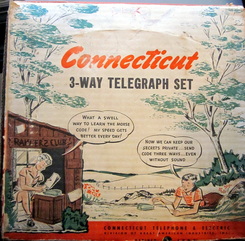Toy and Practice Telegraph Keys
At one time, kids learned the Morse Code and the fundamentals of telegraphy. Many young people were fascinated by secret codes and communicating via electricity and wires. Knowing the Morse Code was considered an essential skill and telegraph keys were desirable toys.
Organizations like the Boy Scouts even sold their own practice sets. Companies like A.C. Gilbert, that made Erector Sets, and Lionel, that made toy trains, also produced toy telegraph sets.
Most toy keys had a buzzer so that you could actually hear the code - sort of - when you pushed the key. Some keys also had signal lamps. In the collection on this page, all of the keys, except the ESL key, are simple strap keys. The key lever is just a flat strap of metal. It's not very sophisticated, but it was cheap and it worked. You can click on any of these images to enlarge them.
Here's the Vintage Radio column that I wrote for QST magazine about Toy Telegraph Keys.
Organizations like the Boy Scouts even sold their own practice sets. Companies like A.C. Gilbert, that made Erector Sets, and Lionel, that made toy trains, also produced toy telegraph sets.
Most toy keys had a buzzer so that you could actually hear the code - sort of - when you pushed the key. Some keys also had signal lamps. In the collection on this page, all of the keys, except the ESL key, are simple strap keys. The key lever is just a flat strap of metal. It's not very sophisticated, but it was cheap and it worked. You can click on any of these images to enlarge them.
Here's the Vintage Radio column that I wrote for QST magazine about Toy Telegraph Keys.
Keys from the USA:
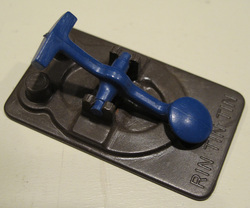
Rin Tin Tin Cereal Box Toy Telegraph Key:
This is a Rin Tin Tin toy telegraph key from the 1950s. This 1 1/4 inch long plastic toy key was found inside of specially marked boxes of Nabisco Shredded Wheat Cereal. Along with the blue one pictured, they also came in green, yellow and white. Here's a picture of the box.
This toy key is not operational since it has no electrical conductors. To make it work, you placed aluminum foil on the end contacts. Even though it is not functional, it is one of my favorite keys. [097]
This is a Rin Tin Tin toy telegraph key from the 1950s. This 1 1/4 inch long plastic toy key was found inside of specially marked boxes of Nabisco Shredded Wheat Cereal. Along with the blue one pictured, they also came in green, yellow and white. Here's a picture of the box.
This toy key is not operational since it has no electrical conductors. To make it work, you placed aluminum foil on the end contacts. Even though it is not functional, it is one of my favorite keys. [097]
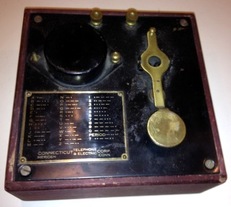
Connecticut Telegraph and Electric Company
Practice Key and Buzzer:
Another practice key and buzzer made by the Connecticut Telegraph and Electric Company in Meriden, Connecticut. This toy has a metal Morse Code chart attached to a box along with a simple brass strap key. The top plate is copper and it is mounted on a wood box. The batteries for the buzzer are contained inside the box. Based on the code characters, this particular KOB was made sometime before 1939. [125]
Practice Key and Buzzer:
Another practice key and buzzer made by the Connecticut Telegraph and Electric Company in Meriden, Connecticut. This toy has a metal Morse Code chart attached to a box along with a simple brass strap key. The top plate is copper and it is mounted on a wood box. The batteries for the buzzer are contained inside the box. Based on the code characters, this particular KOB was made sometime before 1939. [125]
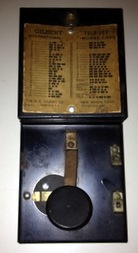
A. C. Gilbert Tele-Set Key:
This metal key was part of the Gilbert Tele-Set that included two keys, a case, buzzer, signal light and replica Western Union telegraph blanks. It measures 3" x 6 3/4" and the key is in very good condition except for a a little rust on the key arm. The key has a chart with the International Morse Code riveted to the top of the case. This key has local origins. It was made by A. C. Gilbert Co, of Erector Set fame, in New Haven, CT.
View the entire Tele-Set Outfit here. [102]
This metal key was part of the Gilbert Tele-Set that included two keys, a case, buzzer, signal light and replica Western Union telegraph blanks. It measures 3" x 6 3/4" and the key is in very good condition except for a a little rust on the key arm. The key has a chart with the International Morse Code riveted to the top of the case. This key has local origins. It was made by A. C. Gilbert Co, of Erector Set fame, in New Haven, CT.
View the entire Tele-Set Outfit here. [102]
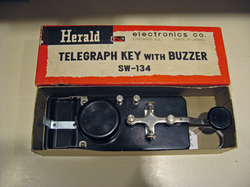
Herald (Not Harold) Telegraph Key with Buzzer
This is a toy black plastic key with buzzer. It uses a steel key and a plastic knob. Connections are made using standard "screw in" binding posts. There is a DC buzzer and a holder for "D" cell battery. This key is in the original box. There is a Morse Code alphabet card inside of box. It says manufactured by the Herald Electronics Company in Chicago and made in Japan. [036]
This is a toy black plastic key with buzzer. It uses a steel key and a plastic knob. Connections are made using standard "screw in" binding posts. There is a DC buzzer and a holder for "D" cell battery. This key is in the original box. There is a Morse Code alphabet card inside of box. It says manufactured by the Herald Electronics Company in Chicago and made in Japan. [036]

Liberty Telegraph Key:
This is a toy or practice Key , It has metal painted base with a buzzer and battery clips on the top. Complete with Box labeled SOS. It is labelled "Marine Telephone and Telegraph Companies Report Shortage of Operators for Ships." I would guess that this is a 1940s vintage practice key. [106]
This is a toy or practice Key , It has metal painted base with a buzzer and battery clips on the top. Complete with Box labeled SOS. It is labelled "Marine Telephone and Telegraph Companies Report Shortage of Operators for Ships." I would guess that this is a 1940s vintage practice key. [106]
International:
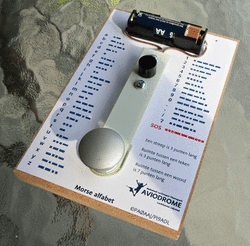
Dutch Aviation Museum Pieper Key (2015)
From: Hans Coelers PA0AAJ, volunteer at the Dutch Aviation Museum:
"This key is used and sold today by the Dutch Aviation Museum. We have a “radio room” with vintage equipment used by KLM Airlines during 1940 and 50s. After explaining and demonstrating to kids the use of Morse Code, they practice keying the letters A and B. Most of them manage to key their name and get excited when we write it down (some kids are only 5 years old). After that, they ask “can I have a beeper “ We build them and sell them for 10 euro each. During a 10 year period, we have sold over 1,000 beepers. We are 10 volunteers (all hams)and the radio room is always open for the public." [145]
From: Hans Coelers PA0AAJ, volunteer at the Dutch Aviation Museum:
"This key is used and sold today by the Dutch Aviation Museum. We have a “radio room” with vintage equipment used by KLM Airlines during 1940 and 50s. After explaining and demonstrating to kids the use of Morse Code, they practice keying the letters A and B. Most of them manage to key their name and get excited when we write it down (some kids are only 5 years old). After that, they ask “can I have a beeper “ We build them and sell them for 10 euro each. During a 10 year period, we have sold over 1,000 beepers. We are 10 volunteers (all hams)and the radio room is always open for the public." [145]

A Training and Practice Key from Belarus:
This is a brown, bakelite practice key from Belaurs. It is about 5' long and 3" wide. The base is about 1 1/4' deep. It has a single lever with a Navy-type knob on the top. There are three electrical terminals on the rear of the base. This key is unusual since there are Cyrillic characters and their Morse Code equivalents pressed into the top of the key. The numbers 1 - 10 and their Morse Code equivalents are pressed into the base. There is a buzzer and battery holder inside the base.
This key is a gift to the collection from the Radio Amateurs of Belarus. Thanks to Dave, K1ZZ and Igor, EW1IP for their assistance in obtaining this key. [171]
This is a brown, bakelite practice key from Belaurs. It is about 5' long and 3" wide. The base is about 1 1/4' deep. It has a single lever with a Navy-type knob on the top. There are three electrical terminals on the rear of the base. This key is unusual since there are Cyrillic characters and their Morse Code equivalents pressed into the top of the key. The numbers 1 - 10 and their Morse Code equivalents are pressed into the base. There is a buzzer and battery holder inside the base.
This key is a gift to the collection from the Radio Amateurs of Belarus. Thanks to Dave, K1ZZ and Igor, EW1IP for their assistance in obtaining this key. [171]

Russian Wooden Telegraph Training Key:
A Russian, wood base, training key with a straight metal lever and plastic knob. It was made for DOSAAF an organization that trained school children in the use of the Morse Code. In English, it means: Voluntary Society of Assistance to the Army, the Air Force and the Navy, a pre-military youth organization. Gift to the collection from Dave, K1ZZ.
[052]
A Russian, wood base, training key with a straight metal lever and plastic knob. It was made for DOSAAF an organization that trained school children in the use of the Morse Code. In English, it means: Voluntary Society of Assistance to the Army, the Air Force and the Navy, a pre-military youth organization. Gift to the collection from Dave, K1ZZ.
[052]
